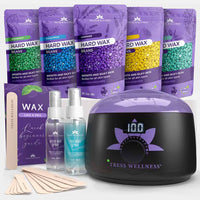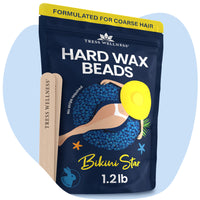If you’re pondering whether hard wax or sugar wax is the right choice for hair removal, you’re not alone. This direct comparison clarifies the ‘hard wax vs sugar wax’ debate, targeting their effectiveness on different hair types, sensitivity levels, and overall user experience. Through clear insights, you’ll be equipped to make an informed decision, steering clear of unnecessary fluff and focusing solely on what matters for smooth skin results.
Key Takeaways
-
Hard wax, ideal for coarse hair, is made of beeswax and rosin heated to a honey-like consistency and can be applied without strips; sugar wax, better for sensitive skin and fine hair, uses natural ingredients and is removed in the direction of hair growth.
-
Both hard and sugar waxes provide smooth skin for 4-6 weeks, but sugar wax can grab shorter hairs and cause less pain and irritation due to its hair- and dead skin cells-specific adherence.
-
Proper post-wax care, including using essential oils and exfoliation, is crucial to prevent discomfort and ingrown hairs, while personal preference and factors like budget and convenience determine the choice between salon visits and DIY waxing.
Understanding Hard Wax and Sugar Wax

When it comes to hair removal, hard wax, soft wax, and sugar wax are all contenders in the ring. Hard wax, a popular choice, is a warm wax that adheres to the hair, not the skin. Its primary ingredients include beeswax and resin—natural components that cause less skin irritation.
On the other hand, sugar wax is a room-temperature paste that, similar to hard wax, clings to your hair instead of your skin for less painful removal. Sugar wax even offers the bonus of being reusable throughout your hair removal session.
Hard Wax: Ingredients and Process
Hard wax is an amalgamation of beeswax and rosin, coupled with oils and vitamins for therapeutic benefits. The typical formulation is a mix of four parts rosin to one part beeswax, supplemented with a small quantity of beneficial oil like olive or coconut. Hard wax is warmed before application, which usually takes about 15 to 20 minutes at a high setting, before the temperature is lowered for the actual application.
Thoroughly cleansing the skin to remove all traces of dirt, makeup, oil, and lotions is a necessary step before lathering on the warm wax. After waxing, applying a pre-wax oil helps to protect the skin by forming a protective barrier. This can minimize irritation and discomfort during the hair removal process. For optimal application, the hard wax should maintain a temperature around 130 degrees Fahrenheit, exhibiting a consistency similar to honey. The wax needs to be warm and pliable, but not excessively hot.
Sugar Wax: Ingredients and Process
Sugar wax, on the other hand, is a concoction of sugar, lemon, and water—natural, biodegradable, and hypoallergenic ingredients that are less likely to irritate the skin. The sugaring paste is applied in the opposite direction of hair growth to ensure proper adherence to the hairs. For the sugaring method to work effectively, the hair needs to be at least one-eighth to one-fourth inch in length.
The removal process involves a flicking method in the same direction as hair growth, pulling the unwanted hair out by the root. This hair removal method not only ensures a thorough way to remove hair but also contributes to a less painful experience compared to traditional waxing methods. With various hair removal options available, this method stands out for its effectiveness and reduced discomfort.
Comparing Hair Removal Results
So, how do these two waxing methods stack up against each other when it comes to hair removal results? Well, both hard wax and sugar wax boast of a hair-free period of 4-6 weeks before regrowth. However, sugar wax is particularly effective in removing fine hair, as it can grip hairs as short as 1/16th of an inch, shorter than traditional waxing can typically manage.
Hard Wax for Thicker Hair

When it comes to tackling thicker hair, hard wax steps into the spotlight. It’s especially effective in areas with coarse hair like the bikini line and facial regions, making it a popular choice for a Brazilian wax.
Hard wax’s features include:
-
Adhering to the hair shaft rather than the skin
-
Shrink-wrapping around the hair
-
Ensuring a firm grip on coarse hair for successful removal from the root.
Hard wax offers several advantages over other types of wax:
-
It allows for a thicker layer of application during the waxing process, eliminating the need for removal strips.
-
This makes the process gentler on the skin.
-
It also allows for retouching the same area if necessary, optimizing it for thicker hair removal.
The removal of hard wax involves pulling it off in the opposite direction of hair growth, effectively extracting hair, including the thicker varieties, from the hair follicles.
Sugar Wax for Sensitive Skin
If you have sensitive skin, sugar waxing may be your winning ticket. It employs all-natural ingredients such as sugar and lemon juice, which are less likely to irritate sensitive skin in contrast to the components of hard wax. Sugar wax adheres to hair and dead skin cells rather than the skin itself, which results in lessened skin irritation and provides a gentle exfoliating effect during hair removal.
The sugar paste is applied at a warm temperature, not hot, offering a more comfortable experience that is suitable for individuals with sensitive skin. The removal of hair using sugar waxing follows the natural direction of hair growth which may contribute to a less painful experience than traditional waxing methods. This is why many people prefer sugaring vs other hair removal techniques.
Pain and Discomfort: Hard Wax vs. Sugar Wax
Waxing often comes with its fair share of discomfort and pain. However, sugar waxing is reported to cause less pain as the sugar paste adheres primarily to hair and dead skin cells, not to living skin cells, which reduces discomfort and redness. The unique application of sugar wax in the opposite direction of hair growth and its removal in the direction of growth leads to lesser pain and irritation, contributing to a more comfortable hair removal experience overall. Interestingly, hard wax can also be quite gentle on the skin if applied correctly and removed with care.
With repeated sugaring sessions, you may experience lighter and sparser hair regrowth, which may decrease discomfort over time as you become more adept at the technique. Similarly, proper technique with hard wax can result in a more pleasant experience, even for those with sensitive skin.
Ingrown Hair and Hair Breakage
While waxing offers many advantages, it also has a few downsides, with ingrown hairs and hair breakage being common issues. These can cause discomfort and irritation, placing a damper on your smooth-skin dreams. But there’s a silver lining! With proper post-wax care, you can minimize these issues.
Exfoliating is a key preventative measure against ingrown hairs. Here’s how to do it:
-
Begin at least two days after waxing.
-
Continue exfoliating a few times a week.
-
Use a dry brush or an exfoliating mitt. Regular exfoliation of the waxed area will lessen discomfort and prevent painful ingrown hairs over time.
Here's how your waxing session will look like if you use proper exfoliation techniques.
@tresswellness_waxingkit Satisfying or not? #hardwax #waxingvideos #satisfyingvideo #waxkit #legwax #usarmy ♬ original sound - Tress Wellness Waxing Kit 💜
Cost and Convenience: Salon vs. DIY
When it comes to cost and convenience, the choice between salon treatments and DIY options can be a tough call. Salon waxing services offer a professional environment, streamlined booking process, and enhance the customer experience. However, prices fluctuate based on factors like the type of service, region, the wax used, and the esthetician’s. A breakdown of typical salon waxing prices might look something like this:
-
Eyebrows: $10 - $25
-
Upper lip: $5 - $15
-
Underarms: $15 - $25
-
Arms: $20 - $40 (half), $30 - $60 (full)
-
Back: $40 - $70
-
Chest: $30 - $55
-
Bikini: $20 - $40 (standard), $30 - $60 (full), $45 - $80 (Brazilian)
-
Legs: $40 - $70 (half), $60 - $100 (full)
These prices are averages and can vary widely depending on the salon's location and prestige, as well as the expertise of the esthetician performing the service.
Alternatively, DIY waxing kits, such as those from Tress Wellness, can be a more economical choice. For instance, using a hard wax kit at home can cost around $40, a worthy investment considering it can be reused over time. Sugar waxing at a salon can vary in price, ranging from $10 for a small area to $90 for full legs. Ultimately, the choice between salon and DIY depends on your budget, time, and comfort level.
Essential Oils and Post-Waxing Care
Post-waxing care holds equal importance to the waxing process itself. It involves the use of essential oils and creams to soothe and protect the skin. Some essential oils that can help calm and rehydrate the skin after waxing are:
-
Tea tree oil
-
Jojoba oil
-
Almond oil
-
Argan oil
-
Lavender oil
These oils have antimicrobial, anti-inflammatory, and hydrating properties. Additionally, coconut oil can act as a sealant post-waxing, retain moisture, and has anti-bacterial properties to protect the skin.
Besides using oils, it’s advisable to:
-
Wear clean, loose-fitting clothes after waxing to avoid irritation
-
Keep the skin clean and moisturized daily to facilitate normal hair regrowth
-
Apply an antiseptic cream for three days following waxing to protect and soothe the waxed area.
Summary
In conclusion, both hard wax and sugar wax have their unique advantages. Hard wax is excellent for removing thicker hair, while sugar wax is gentler on sensitive skin and causes less pain. Both methods can give you hair-free skin for 4-6 weeks. However, the choice between the two hinges on your personal needs, skin type, hair thickness, and pain tolerance.
Frequently Asked Questions
Is Sugar Waxing better than hard wax?
In general, while both sugaring and waxing are competent hair removal methods, hard wax often takes the lead for those seeking a more effective solution for coarse hair. Its superior grip and ability to shrink-wrap around the hair make it the preferred choice, especially for areas like the bikini line and underarms. The beeswax and rosin formulation of hard wax is also noted for being less painful on sensitive areas, making it a strong contender for the best hair removal option.
Is Hard wax better for Brazilian?
Yes, hard wax is better for a Brazilian wax because it is effective for coarse hair and less painful for sensitive areas.
Which lasts longer waxing or sugaring?
Both sugaring and waxing last for a similar amount of time, providing smooth results that can last for approximately 4 to 6 weeks.
What about ingrown hairs and hair breakage?
Ingrown hairs and hair breakage can be common after waxing, but you can minimize these issues with regular exfoliation and proper post-wax care.




